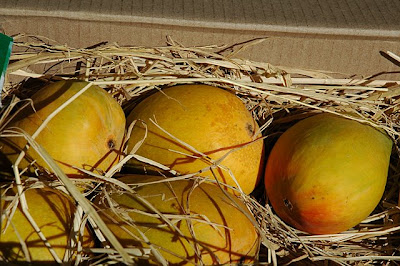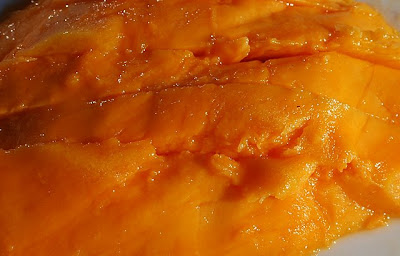_seed_pod_20090905.jpg)
Trypophobia inducing seed head of sacred lotus (Nelumbo nucifera)
A few weeks ago I was contacted by Arnold Wilkins, professor in psychology at the University of Essex, who sought permission to reproduce the above image of a lotus seed pod in a scientific publication on trypophobia. I had never heard about trypophobia before but a quick investigation revealed that the term was coined recently, combining the Greek trypo (punching, drilling, or boring holes) and phobia (an extreme or irrational fear of or aversion to something). Research on trypophobia is still limited and the condition is not recognized in the American Psychiatric Association's Diagnostic and Statistical Manual of Mental Disorders. Still, thousands of people claim to be fearful of objects with small holes, such as beehives, ant holes, and lotus seed heads. There's even a website dedicated to trypophobia with loads of pictures of stuff with holes in it. Trypophobia is also called repetitive pattern phobia.
I always found my lotus seed pod image nothing but beautiful and couldn't (still quite can't) understand that a picture like this would cause anxiety in anybody. Anyway it will soon appear in an academic article on trypophobia and I'll bring an update when it's published.
I know it's entirely unscientific but I set up the poll below to get a better understanding of how many people are actually disturbed by the sight of the lotus seed head:
The image originally appeared in a post on Brooklyn Botanic Garden.
Tuesday, May 07, 2013
Trypophobia - fear of holes
Tuesday, December 07, 2010
Intermission
I’ve been a bit lax updating the blog lately as a new beautiful flower has entered my life - she is more wonderful than even the most stunning peyote so my priorities have shifted slightly ;-)
That being said, I’ll be back with new posts soon, so stay tuned. In the meantime enjoy the music ;-)
Saturday, February 06, 2010
The stone flowers of the Taj Mahal
I spent two weeks working in Delhi, India during January. I had one weekend off and had planned to spend it in Delhi at my own leisure, but when the guys I worked with offered to take me to Agra and show me the Taj Mahal I off course promptly accepted.

The Taj Mahal
The Taj Mahal is one of the most famous buildings in the world. The magnificent white marble mausoleum is the tomb of Mughal empress Mumtaz Mahal, the favorite wife of Mughal emperor Shah Jahan. Mumtaz Mahal died in 1631 while giving birth to their 14th child and Shah Jahan commissioned the Taj Mahal as a monument and tomb for his beloved wife (and later of Jahan himself). So it’s understandable that the Taj is told in most tourist guides as a true monument to love, or “a teardrop on the face of time” as the British historian Michael Wood poetically phrases it.

South facade of the Taj Mahal
The Taj Mahal rises up on a marble platform that makes it seem to almost float in mid-air when observed from the entrance gateway of the complex. The precise proportions and strict symmetry of the structure are incredible to watch and permeate everything from the minarets and facades on the large scale to the floral motifs inlaid with stone on the small scale.

Floral motifs inlaid with stone above the south portal
The four facades of the tomb are identical and each has a grand portal, known as an iwan or pishtaq. Each portal is bordered by a rectangular frame decorated with inscriptions of verses from the Qur’an inlaid with black marble. The triangular spaces on either side of the point of the arch are decorated with carved arabesque and floral designs inlaid with semiprecious stones.

Decorated marble plinths inside the south portal
In Islamic culture flowers are often seen as symbols of Paradise; the kingdom of God. And stone flowers are everywhere at the Taj Mahal - flowers depicted with realism, yet with a soft lyricism that almost makes you forget they are carved in marble or inlaid with stone. And again the perfect symmetry is everywhere.
One can only admire the artisans who crafted these exquisite marble carvings; marble is a very hard stone to cut and they worked with large slabs of marble – in the above photo there goes 3 “plants” to one slab of marble. In case the craftsmen made just the smallest mistake they would have to ditch the whole slab and start from scratch.

Flower cut in marble, south portal

Floral designs inlaid with stone, south portal
As you enter the burial chamber of Mumtaz Mahal the floral motifs become even more pronounced and eminently detailed. Flowers – both cut and inlaid with stone – are absolutely everywhere. Photography is not allowed within the tomb, but I managed to “sneak in” a couple of (no flash) pictures while the guards were otherwise occupied (I hope taking pictures inside the tomb is not considered rude or bad taste – to my defense I’ll say that the Indian visitors also let loose and took lots of pictures while the guards were gone ;-)

Detailed floral pattern inlaid with stone, burial chamber
It has been said that the only discordant note in the Taj is, ironically enough, the tomb of Shah Jahan placed next to that of Mumtaz. The building was designed so that Mumtaz’s tomb would be its single centerpiece directly below the central dome in the octagonal burial chamber – Shah Jahan’s tomb breaks the symmetry that otherwise permeates the whole construction.

Inscriptions from the Qur’an inlaid with black marble

The main tomb building of the Taj Mahal
Four minarets sit at the corners of the square, raised marble platform that houses the main tomb building. Each slender, round tower is made of white marble, outlined in inlaid black stone, and includes a winding internal staircase leading up to its gallery (which is no longer used to call the faithful to prayer, though)

Minaret at the Taj Mahal
If you have the chance, seeing the Taj Mahal is a must – its ethereal, sad beauty will silence even the most cynical of world travelers.
As a foreigner visiting the Taj Mahal be prepared for a massive difference in entrance fees, though – I paid 750 INR while my Indian friend had to pay only 20 INR. I understand why this is done but I don’t like the signal it’s sending. Maybe I’m just grumpy but after many visits to India I’m growing weary of the ubiquitous (and often professional) beggars and hustlers that seem to think that westerners are walking ATMs that will dispense cash on demand, and it makes me sad to see that even the official India, in this case represented by the Archaeological Survey of India, condones this view.

Tickets to the Taj Mahal
I just watched Michael Wood’s The Story of India and new discoveries apparently suggest that the design of the Taj Mahal might go back to Sufi saints – that the key to the Taj may be a mystic map of a Sufi’s dream, a map where different parts of the Taj Mahal complex represents different elements of the judgment day.

Monkeys at Agra Fort
It has absolutely nothing to do with the Taj Mahal, but I couldn’t resist posting this photo of a couple of monkeys living at the nearby Agra Fort. The monkeys seem to be seriously contemplating if they really need to adhere to the directives on the sign – or if they instead should be frolicking on the lawn, tearing off leaves and eating flowers.
Sunday, April 05, 2009
Ramsons covering the forest floor
This post is very much off the usual topic – now you are warned ;-)

Ramsons basking in the spring sun
Spring has finally arrived in Denmark and is being heralded by one of its early messengers: ramsons. Ramson (Allium ursinum) (also known as buckrams, wild garlic, broad-leaved garlic, wood garlic, and bear's garlic) is a wild relative of chives and grows in deciduous woodlands – fortunately such a forest is located only a couple of kilometers from where I live.

Ramsons covering the forest floor
Ramson is easily distinguished from other plants of the forest by the distinctive, garlicky smell of its leaves. On calm warm days, during the ramson season, the whole forest is enveloped in a cloud of mild garlic odors. When the plants flower the smell can grow really intense – some might even refer to it as a pungent stench ;-)
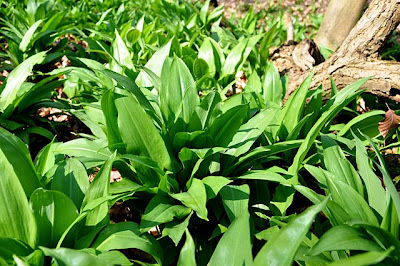
Carpet of ramsons

Ramson leaves, close-up
When not flowering, the extremely poisonous Lily of the Valley (Convallaria majalis) might be mistaken for ramsons – fortunately you can tell ramson by its smell ;-) All parts of ramson are edible and make for a great supplement to your spring menu.

Lesser celandine flower, close-up
Another messenger of spring in many Danish deciduous forests is the lesser celandine (Ranunculus ficaria (syn. Ficaria verna)) (also known as fig buttercup, and fig wort). Their extremely shiny, looking almost plastic-like, yellow flowers and lustrous dark-green heart-shaped leaves make these plants stand out on the spring forest floor.

Lesser celandine
Last but not least, I must mention the white anemone (Anemone nemorosa) (also known as wood anemone, windflower, thimble weed, and smell fox) – in select locations the anemones virtually blanket the forest floor.

Wood anemone flower, close-up

Wood anemone blanket

Flowering wood anemones
In a few weeks the canopy will be covered in foliage again – until then the dwellers of the forest floor rule.

Forest overlooking the Aarhus bay
Update - May 11, 2009
The deciduous forest is now almost fully leafed-out and it is time for the ramsons to flower.
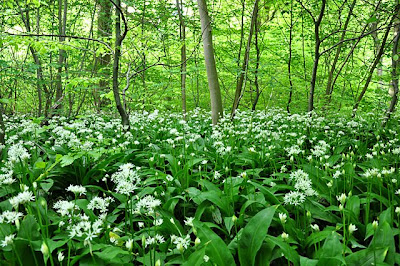
Flowering ramsons covering the forest floor
The older leaves tend to have a more pungent smell than the small, younger ones and if you trample through a stand of flowering ramsons the garlicky odor can be really overwhelming.
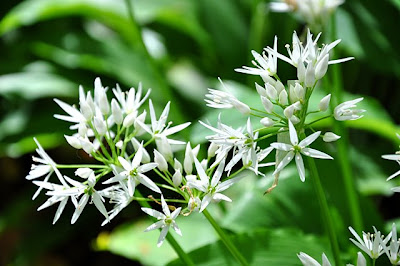
Ramsons flower, close-up
As all other parts of ramsons the flowers may also be eaten and are said to make an interesting garnish for salads – I haven't tried that though.
Friday, November 28, 2008
Mumbai musings
I was supposed to have been in Mumbai this week. When visiting I stay, work, and spend my time off in the exact part of town where most of the terrorist attacks happened.
Fortunately my travel plans were changed but still I'm left with a bewildering array of feelings including sorrow, sadness, relief, anger, and fear – combined with a nagging disbelief of how scaringly few “ifs” it would have taken to place me at the scene.
I hope the city and people of Mumbai rise from this attack without giving in to the code of fear and violence imposed on them by the terrorists.
Sunday, June 01, 2008
Munching on alphonso mangoes in Mumbai
This is very much off-topic, I know, but I’m just home from Mumbai (Bombay), India and have to share this ;-) I visited Mumbai for two weeks, just before the monsoon set in. As it turned out this period coincided with the last part of the alphonso mango season. I had never tasted alphonso mangoes before, but their warm, deep orange-yellow color (almost like an egg yolk), the smooth, firm texture of the fruit flesh (not fibrous at all, reminiscent of an almost ripe avocado), and their sweet, mild, mild, mild bergamot-like taste immediately won me over. I ate alphonso mangoes whenever I could find them and even brought home a dozen ;-)
A box of alphonso mangoes
Alphonso mangoes surrounded by straw
Alphonso mangoes close-up
Alphonso mango ready to eat
All Time Most Popular Posts
-
Lophophora williamsii (peyote) populations have diminished in large areas of South Texas where peyoteros harvest the cactus for ceremonial ...
-
On various occasions I've been asked what growing media I'm using for my cactus plants. I don't have a set soil mix recipe as su...
-
Below is a list of retailers/nurseries selling cactus seed and plants. I've only listed vendors I've done business with. If you ar...
-
Most cacti are easily grown from seed - and with a little patience and care they can be grown into beautiful plants. Lophophora williamsi...
-
In last month’s post on the troubled Texan peyoteros I referred to Anderson’s article on the peyote situation in Texas. Given the importanc...
-
Yet another slightly off topic and probably not entirely politically correct post, but I couldn’t help noticing the similarity of my monstr...
-
Flowering stand of San Pedro cacti (Trichocereus pachanoi) To me the main draw of the San Pedro cactus ( Trichocereus pachanoi (syn. Ech...
-
In the June 2008 issue of the Cactus & Co magazine Jaroslav Šnicer, Jaroslav Bohata, and Vojtěch Myšák described a new Lophophora spec...
-
There seems to be an increased focus on the alarming Texas peyote situation. A couple of weeks ago the Houston Press published a mournful, i...
-
I spent two weeks working in Delhi, India during January. I had one weekend off and had planned to spend it in Delhi at my own leisure, but ...

